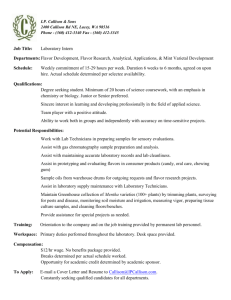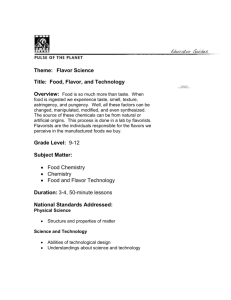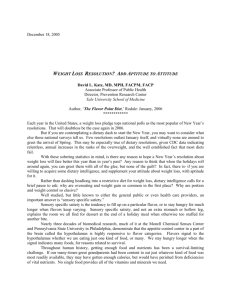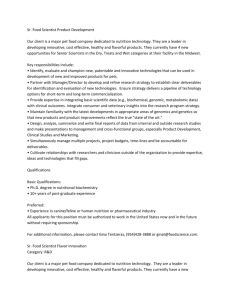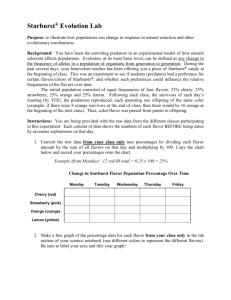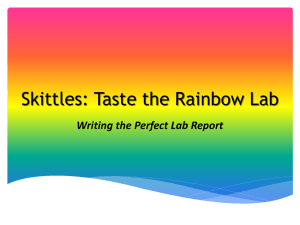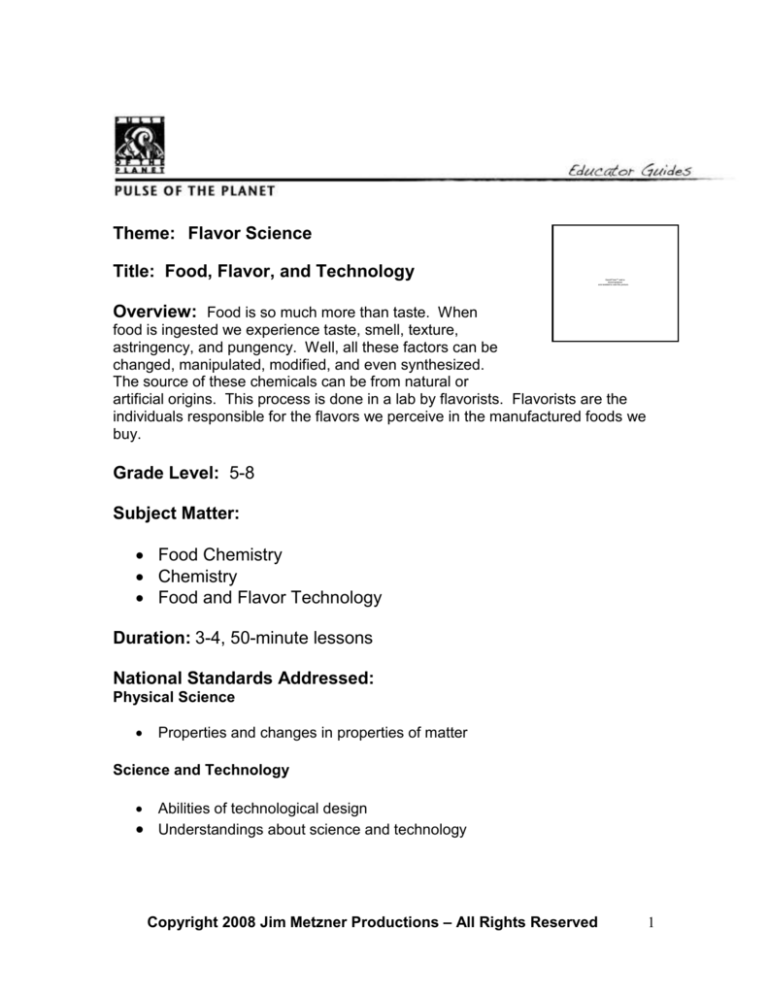
Theme: Flavor Science
Title: Food, Flavor, and Technology
QuickTime™ and a
decompressor
are needed to see this picture.
Overview: Food is so much more than taste. When
food is ingested we experience taste, smell, texture,
astringency, and pungency. Well, all these factors can be
changed, manipulated, modified, and even synthesized.
The source of these chemicals can be from natural or
artificial origins. This process is done in a lab by flavorists. Flavorists are the
individuals responsible for the flavors we perceive in the manufactured foods we
buy.
Grade Level: 5-8
Subject Matter:
Food Chemistry
Chemistry
Food and Flavor Technology
Duration: 3-4, 50-minute lessons
National Standards Addressed:
Physical Science
Properties and changes in properties of matter
Science and Technology
Abilities of technological design
Understandings about science and technology
Copyright 2008 Jim Metzner Productions – All Rights Reserved
1
History and Nature of Science
Personal health
Science and technology in society
Objectives:
By the end of the lesson, the students will be able to:
Identify the tasks of flavorists and food chemists.
Describe and list different food additives and their functions in food.
Differentiate between natural and artificial foods and food additives.
Describe how and why flavor is manipulated.
Materials:
Computers
Internet access
PowerPoint program
Various flavors of Kool-Aid
Various alcohols and acids (see Ester Lab)
Items for “It’s All in the Taste” Lab
Procedure:
1. Hook:
a.
b.
c.
Invisible Kool-Aid Taste Test
Provide samples of invisible Kool-Aid to your students.
Do not divulge the flavors. Label the samples A, B, C etc.
Provide a tasting sheet and see if they can correctly identify the
flavors.
d. Reveal the answers and discuss.
e. Outcome: there should be a handful of students that miss at least
one (or more) of the flavors.
2. Specialists in the field
a. History of Flavors: Hand out the Pulse of the Planet program
worksheet entitled: “A Short History of Flavoring Food”
i. Play the program for the class at least twice, more is
desired.
ii. Give time to answer the questions – especially the last one.
iii. Discuss the answers in class
iv. Segue into the next program
b. Flavor Chemists
i. Play the program for the class at least twice, more is
desired.
ii. Give time to answer the questions – especially the last one.
iii. Discuss the answers in class
iv. Segue into the next program
Copyright 2008 Jim Metzner Productions – All Rights Reserved
2
c. As a point of interest, view the video on a flavor chemistry lab:
http://dsc.discovery.com/videos/inside-a-flavor-lab.html
3. Food Additives
a. Introduce the next section by preparing a PowerPoint presentation
on the following questions.
b. Write the students responses to the questions on the board.
i. What do you know of that can be added to food to make it
taste better?
ii. What do you know of that can be added to food to make it
last longer on the shelf or your refrigerator?
iii. Do you know of anything that can be added to your food as
an alternative to the real thing i.e. Sweet’n Lo?
iv. Do you know of anything that is added to food that has been
know to be harmful to you?
c. Class Participation/Demonstration
i. Below, background notes have been provided in clearly label
sections.
ii. Describe the content below orally and use the suggested
demonstrations provided after each section. These are just
suggested demonstration.
iii. When at all possible, try to have the students taste as much
as they can to involve them in the lesson as much as
possible.
4. Food Chemistry and Industry
a. Gum Challenge:
i. Pass out several types/brands of gum of varying “quality,”
price, and advertising. Four to five brands should be
enough.
ii. Put students in groups of four or five (depending on the
number of types of gum you bought)
iii. Have the students chew the gum and record their
observations on the lab sheet entitled “Gum Challenge Data
Sheet.”
iv. Distribute the gum samples and allow the students to begin.
v. The gum with the longest lasting flavor is a product of
microencapsulation. Use this fact to segue into the next
portion of the lesson.
b. Briefly introduce the ideas of microencapsulation and flavor
manipulation – two representative practices in food chemistry and
industry.
c. Distribute the handout “Food Chemistry and Industry”
i. Students can work alone or in pairs at a computer.
ii. Provide students with access to the prescribed Pulse of the
Planet programs.
iii. Announce a date that the study guide is due.
Copyright 2008 Jim Metzner Productions – All Rights Reserved
3
5. Manipulation of flavors
a. Introduce this section with these comments;
i. Reiterate how flavor is a combination of several factors:
taste, smell, texture, astringency, etc.
ii. Describe that flavors can break down over time or during the
manufacturing process.
iii. Describe that even though some foods are good for you the
flavors are not desirable.
iv. All these items can be changed to suit the current trend in
foods.
v. This is done by food chemists, a.k.a. flavorists.
b. Dispense the study guide entitled “Food Chemistry and Industry.”
c. Students can work in groups if you like.
d. Establish due-dates.
6. Final Assessment Suggestion
a. A lab practical of esters could be made.
i. The students could be given and unknown alcohol and acid
with directions.
ii. The students would follow the procedure and obtain results
in the form of a scent.
iii. From the scent they would identify the ester created as well
as the unknown alcohol and unknown acid.
Handouts:
A Short History of Flavoring Food
Pulse of the Planet program #4337: “Science Diary: Flavor –
Ingredients”
Answer the following questions as the program is played in class.
The teacher will play the program at least twice.
1. How did people add flavor to foods in the 1800’s?
2. Later, food was flavored with ______________ ______.
3. By the 1950’s, food chemists were making _______________
flavors because they could understand the chemistry behind
food.
4. Which has a stronger taste: natural flavors or synthetic flavors.
(circle one)
Copyright 2008 Jim Metzner Productions – All Rights Reserved
4
5. When you eat candy, are there any real natural ingredients in
it?
Flavor Chemists
Pulse of the Planet program #4341: “Science Diary - Flavor: All
in the Taste”
Answer the following questions as the program is played in class.
The teacher will play the program at least twice.
1. Describe what a Flavor Chemist does for a living?
2. Do you think any of the chemicals that Joan Harvey tastes are
going to hurt her? Describe your answer.
3. What is the purpose of diluting the chemicals down to a point
where she couldn’t taste them anymore?
4. Do strong flavors taste different than diluted flavors? Think
about really sugary, strong Kool-Aid versus Kool-Aid with just a
little sugar.
Food Additives Interactive/Demonstration Lesson
To the teacher: Please use the following notes below to
compose a PowerPoint slide show for the students to take notes
on.
What is a food additive?
A food additive is defined as this: “any substance the intended
use of which results or may reasonably be expected to result—
directly or indirectly—in its becoming a component or otherwise
affecting the characteristics of any food.”
Demonstrations:
o Add salt/pepper to mashed potatoes/fries etc.
o Add sugar to iced tea.
o Any addition of flavor to any food will do.
Copyright 2008 Jim Metzner Productions – All Rights Reserved
5
Why are additives used?
To Maintain or Improve Safety and Freshness:
o Preservatives slow product spoilage caused by yeast,
mold, bacteria, fungi, or exposure to air
o they help control contamination that can cause food borne
illness.
o antioxidants—prevents fats and oils, and the foods
containing them, from becoming rancid or developing an
off-flavor.
o prevents fresh fruits such as apples from turning brown
when exposed to air.
o Examples of preservatives: ascorbic acid, butylated
hydroxyanisole (BHA), butylated hydroxytoluene (BHT),
and sodium nitrite.
Demonstrations:
o Cut up an apple ahead of time to give it time to brown.
Record the time of oxygen exposure.
o In front of the class, cut up an apple and a lemon.
Squeeze the lemon on the apple after an elapsed time (at
least a 30 minutes) compare the two test subjects.
To Improve or Maintain Nutritional Value:
o Vitamins and minerals (and fiber) are added to many
foods to make up for those lacking in a person’s diet or
lost in processing.
o Enhance the nutritional quality of a food.
o Enrichment - the restoration of nutrients lost during food
processing. In this case, the amount of nutrients added is
approximately equal to the natural content in the food
before processing.
o Fortification - the amount of nutrient added may be higher
than that present before processing. Fortification also
standardizes the contents of nutrients that show variable
concentrations.
i. Example: the addition of vitamin C to orange juice
to standardize vitamin C concentration and
Copyright 2008 Jim Metzner Productions – All Rights Reserved
6
compensate for changes due to seasonal and
processing variations. Such fortification and
enrichment has helped reduce malnutrition in the
U.S. and worldwide. Grains, flours, milk, margarine,
and other foods are enriched or f
ii. fortified by adding vitamins A and D, iron, ascorbic
acid, calcium, niacin, riboflavin, folic acid, zinc, and
thiamin. All products containing added nutrients
must be appropriately labeled.
Demonstrations
o Find food with packaging that states “fortified with…”
o Orange juice, vitamin D milk, fruit juices.
To Improve Taste, Texture, and Appearance:
o Spices, natural and artificial flavors, and sweeteners are
added to enhance the taste of food.
o Food colors maintain or improve appearance.
o Emulsifiers, stabilizers and thickeners give foods the
texture and consistency consumers expect.
o Leavening agents allow baked goods to rise during
baking.
o Some additives help control the acidity and alkalinity of
foods, while other ingredients help maintain the taste and
appeal of foods with reduced fat content.
Demonstration
o Bring in and show a bag of Sunkist brand oranges and
compare these to natural (off-the-tree) oranges. The two
look strikingly different but often the off-the-tree oranges
taste better. This shows that oranges are often sprayed
to make them look better.
Common Food Additives
Low-Calorie Sweeteners
o Low-calorie sweeteners add a sweet flavor to foods
without adding a significant amount of calories.
o Low-calorie sweeteners are several hundred to several
thousand times sweeter than sucrose.
Copyright 2008 Jim Metzner Productions – All Rights Reserved
7
o Most do not contain any calories, exception: aspartame –
however used in such small amounts due to its
sweetening power that it does not contribute sufficiently to
the calorie content.
o Do not affect insulin levels
o Do not cause dental cavities (tooth decay).
o There are five low-calorie sweeteners currently approved
by the Food and Drug Administration (FDA) for use in the
United States:
acesulfame potassium (Ace-K)
aspartame
neotame
saccharin
sucralose.
See the table on sweeteners at:
http://www.ific.org/nutrition/ingredients/index.cfm
Demonstrations
o Splenda is sucralose. Find any product with Splenda in it.
o Bring in White sugar packets – processed sugar; Brown
sugar packets – natural sugar; pink packets – Sweet’n Lo:
Yellow – Splenda; Light Blue – Equal.
Food Colors
o A color additive is any dye, pigment, or substance which
when added or applied to a food is capable (alone or
through reactions with other substances) of imparting
color.
o FDA is responsible for regulating all color additives to
ensure that foods containing color additives are safe to
eat, contain only approved ingredients and are accurately
labeled.
o Color additives are used in foods for many reasons:
to offset color loss due to exposure to light, air,
temperature extremes, moisture, and storage
conditions;
to correct natural variations in color;
to enhance colors that occur naturally; and 4) to
provide color to colorless and “fun” foods. Without
color additives, colas wouldn’t be brown, margarine
Copyright 2008 Jim Metzner Productions – All Rights Reserved
8
wouldn’t be yellow, and mint ice cream wouldn’t be
green.
o FDA’s permitted colors are subject to rigorous safety
standards prior to their approval and listing for use in
foods. Color additives used in foods fall into two groups:
those that are subject to certification and those that are
exempt from certification.
Certified colors are synthetically produced (human
made) and used widely because they impart an
intense, uniform color, are less expensive, and
blend more easily to create a variety of hues. There
are nine certified color additives approved for use in
the United States (See chart for complete list.).
Certified food colors generally do not add
undesirable flavors to foods.
Colors that are exempt from certification include
pigments derived from natural sources such as
vegetables, minerals, or animals. Nature-derived
color additives are typically more expensive than
certified colors and may add unintended flavors to
foods. Examples of exempt colors include annatto
extract (yellow), dehydrated beets (bluish-red to
brown), caramel (yellow to tan), beta carotene
(yellow to orange), and grape skin extract (red,
green).
Demonstrations
o Kool-Aid packets have the colorings listed. Also, M&M’s
have the coloring listed.
Caffeine
o Caffeine is a naturally occurring substance found in the
leaves, seeds, or fruits of more than 60 plants. Food and
beverages derived from cocoa beans, kola nuts, and tea
leaves often contain some caffeine.
o In the United States, coffee is the chief source of dietary
caffeine. In addition, caffeine is added to some foods and
beverages as a flavoring.
Copyright 2008 Jim Metzner Productions – All Rights Reserved
9
o Caffeine from coffee and tea beverages has been part of
the world’s diet for thousands of years. Caffeine was
classified as “generally recognized as safe” (GRAS)
ingredient in 1958. Since that time, numerous studies
have been conducted on caffeine and have shown that
moderate amounts of caffeine—about 300 milligrams per
day—are safe for most adults, including pregnant women.
o See the chart at the following site for caffeine information:
http://www.ific.org/nutrition/ingredients/index.cfm
Demonstrations
o Bring in Red Bull, Coffee, Tea etc. and compare the
Caffeine levels using the website above.
Esters
Formed by a reaction between an alcohol and an organic acid
Esters are derived from carboxylic acids. A carboxylic acid
contains the -COOH group, and in an ester the hydrogen in this
group is replaced by a hydrocarbon group of some kind. See
pictures at the following site:
http://www.chemguide.co.uk/organicprops/esters/background.ht
ml
Volatile esters, esters that evaporate readily, can have pleasant
smells. They are found in perfumes, pheromones, and fruit.
Made using a condensation reaction. Condensation reactions
are named because water is a product from the reaction.
Nomenclature: names end in –ate or –oate.
See the following site for an extensive list of esters:
http://en.wikipedia.org/wiki/Ester
Demonstrations
o Have the students sample any of the food with the above
mentioned esters. Candy will be an excellent source of
ester sampling.
Copyright 2008 Jim Metzner Productions – All Rights Reserved
10
For additional information see the following sites/program:
o Pulse of the Planet program # 4337: “Science Diary –
Flavor: Ingredients,”
o http://www.ific.org/nutrition/ingredients/index.cfm
o http://www.extension.iastate.edu/Publications/NCR438.pd
f
o http://www.cfsan.fda.gov/~dms/eafus.html
o http://www.chemguide.co.uk/organicprops/esters/backgro
und.html
Gum Challenge Data Sheet
Objective: Observe the different qualities of flavor, length of
flavor, type of flavor for several brands of gum.
Fill in the table below. When a rank is needed, use five as high
and one as low.
Type of
gum
Initial flavor
intensity (15)
Initial
Texture of
flavor
gum (after 2
description minutes of
chewing)
Length of
flavor
(minutes)
Copyright 2008 Jim Metzner Productions – All Rights Reserved
11
Food Chemistry and Industry
Complete the following study guide. Use the internet and Pulse
of the Planet Programs to help you. Answer the questions on a
separate piece of paper.
Microencapsulation
1. If most of the flavoring in the food industry is in the form of a
liquid, how do scientists and engineers solve the problem of
getting a liquid flavor on dry food?
2. What is the role of starch in the process of microencapsulation?
3. Describe the industrial mechanical process of
microencapsulating food with a flavored liquid.
4. What does volatile mean?
5. How might volatility cause a problem in the food industry?
6. How does microencapsulation solve the problem of volatility?
How long would a food’s flavor last with microencapsulation
technology?
7. How big are the microencapsulation particles?
8. How does microencapsulation protect a food’s nutritional
value?
9. How pervasive is microencapsulation in our society?
10. Is food the only thing that can be microencapsulated?
11. Make a list of 20 non-food items that can be/have been
microencapsulated.
12. How can the timing of the flavor of gum be manipulated?
Describe the techniques with water and solid flavors.
13. How have scratch-n-sniff stickers and advertisements arisen
from microencapsulation technology? Describe how it works.
14. List and describe the four mechanisms by which the
microencapsulated material is released from the encapsulating
medium.
Copyright 2008 Jim Metzner Productions – All Rights Reserved
12
Resources:
Pulse of the Planet program #954: “MICROENCAPSULATION”
Pulse of the Planet program #955: “MICROENCAPSULATION
– Saving Flavors”
Pulse of the Planet program #4348: “Science Diary – Flavor:
Layers of Flavor”
http://www.swri.org/4ORG/d01/microenc/microen/default.htm#s
hellMaterials
http://www.swri.org/3pubs/ttoday/summer95/microeng.htm
Flavor Manipulation
1. How can the timing of the flavor of gum be manipulated?
Describe the techniques with water and solid flavors. (You may
reference your answer to #12 from above)
2. What is a flavorist?
3. What about our society and tastes keeps a flavorist in demand?
4. Why does it take so long for a flavorist to concoct the perfect
flavor?
5. List everything that fits into our flavor perception.
6. What are the “ingredients” called that flavorists add to preserve
and manipulate food flavor?
7. How many of these chemicals are there (answer to #6)?
8. What are chemicals from natural sources called? Similarly,
what chemicals from artificial sources called?
9. What does a masking agent do? Why would food scientists
add these to foods?
10. What is a food enhancer?
11. Why are food enhancers added to food?
12. List some food enhancers.
13. What is a modifier and how does it manipulate food flavor?
14. List some common food modifiers.
Resources:
Pulse of the Planet program #4348: “Science Diary – Flavor:
Layers of Flavor”
http://recipes.howstuffworks.com/flavor-science.htm
http://www.naturalproductsinsider.com/articles/241fbff1.html
Copyright 2008 Jim Metzner Productions – All Rights Reserved
13
Additional Resources
Web Sites
Food Science – Penn State University
http://www.foodscience.psu.edu/outreach/fun_food_science.html
Food Ingredients and Colors (why, what, how – scroll down for types of additives)
– FDA / IFIC
http://www.cfsan.fda.gov/~dms/foodic.html
Lipotechnologies.com (commercial website)
http://www.lipotechnologies.com/
Microencapsulation and Food Related Applications – University of California
http://foodscience.ucdavis.edu/research/microencapsulation
Microencapsulation – Ohio History Central
http://www.ohiohistorycentral.org/entry.php?rec=2711
Preparedfoods.com
http://www.preparedfoods.com/
How Do Artificial Flavors Work? – Howstuffworks.com
http://science.howstuffworks.com/question391.htm
Do Food Manufacturers Manipulate Taste? _ Howstuffworks.com
http://recipes.howstuffworks.com/flavor-science.htm
Aldehyde – Infoplease.com
http://www.infoplease.com/ce6/sci/A0803153.html
Does Your Chewing Gum Loose Its Flavor? (PDF case study) – University of
Illinois
http://en.wikipedia.org/wiki/Ester
Science of Cooking – Exploratorium.edu
http://www.exploratorium.edu/cooking/
Taste and Flavor Facts – Discovery Channel
http://www.discoverychannel.co.uk/science/kitchen_chemistry/taste_flavour/index
.shtml
Additives – Sustainabletable.org
http://www.eduplace.com/science/hmxs/ps/modf/cricket/sect1cc.shtml
Copyright 2008 Jim Metzner Productions – All Rights Reserved
14
Fantastic Flavours Home Page
http://www.fantastic-flavour.com/home
Audio
Food Science (various) – Discovery Education
http://school.discoveryeducation.com/foodscience/college_resources.html
Flavors and Colors (various) – Preparedfoods.com
http://www.preparedfoods.com/HTML/Application_Videos/BNP_GUID_9-52006_A_10000000000000241707
Inside a Flavor Lab – Discovery Channel
http://dsc.discovery.com/videos/inside-a-flavor-lab.html
Video
Food Science (various) – Discovery Education
http://school.discoveryeducation.com/foodscience/college_resources.html
Flavors and Colors (various) – Preparedfoods.com
http://www.preparedfoods.com/HTML/Application_Videos/BNP_GUID_9-52006_A_10000000000000241707
Inside a Flavor Lab – Discovery Channel
http://dsc.discovery.com/videos/inside-a-flavor-lab.html
Interactive Graphics
Pizza Explorer (history, games, info, etc…) – Institute of Food Technologists
http://members.ift.org/IFT/Education/EduResources/pizza.htm
Candy-o-matic (find out how different candies are made) – Exploratorium.edu
http://www.exploratorium.edu/cooking/candy/index.html#
Articles
The Art and Science of Microencapsulation” – The Southwest Research Institute
http://www.swri.org/3pubs/ttoday/summer95/microeng.htm
Gut Hormone Makes Food Look Even Yummier – Science Daily
Copyright 2008 Jim Metzner Productions – All Rights Reserved
15
http://psufoodscience.typepad.com/psu_food_science/2008/05/gut-hormonemak.html
“Flavor & Nutrient Protection” (08/08) – Prepared Foods
http://findarticles.com/p/articles/mi_m3289/is_8_177/ai_n28025363
“What’s Natural?” (05/12/04) – Washington Post
http://www.washingtonpost.com/wp-dyn/articles/A17036-2004May11.html
“Fake Fat: Z Trim Makes the Cut” – ConsumerReports.org
http://www.consumerreports.org/cro/food/news/z-trim-fat-substitute-1107/overview/z-trim-fat-substitute-ov.htm
“Why McDonald’s Fries Taste So Good”(excerpt) – Fast Food Nation / Eric
Schlosser
http://www.rense.com/general7/whyy.htm
“What’s the Difference Between Artificial and Natural Flavors?” – Scientific
American / Gary Reineccius
http://www.sciam.com/article.cfm?id=what-is-the-difference-be-2002-07-29
“You’re a What? Flavorist” (Winter 04-05) – Occupational Outlook Quarterly
http://www.bls.gov/opub/ooq/2004/winter/yawhat.htm
Other
Flavor Chemistry (PowerPoint presentation) – Ohio State University
http://www.fst.ohio-state.edu/min/Flavor%20Chemistry.htm
Taste Buds (activity) – University of Michigan
http://www.reachoutmichigan.org/funexperiments/agesubject/lessons/tastebud.ht
ml
“Esters: The Preparation and Identification
of an Artificial Food Flavor” (worksheet) – Chymist.com / David. A. Katz
http://www.chymist.com/esters.pdf
Photos and graphics
Name: Olestra Molecule
URL: http://en.wikipedia.org/wiki/Image:Olestra.png
Caption: A ball and stick model of Olestra, showing a central sucrose molecule
with ester-linked fatty acids
Credit: Solarcaine
Copyright 2008 Jim Metzner Productions – All Rights Reserved
16
Name: Cellulose 3D Molecule
URL: http://en.wikipedia.org/wiki/Image:Cellulose-3D-balls.png
Caption: Three-dimensional structure of cellulose, with four glucose units visible.
(Black=carbon; red=oxygen; white=hydrogen.)
Credit: Benjah BMM27
Name: Sugar Crystals
URL: http://en.wikipedia.org/wiki/Image:Sugar_2xmacro.jpg
Caption: Magnification of grains of sugar, showing their monoclinic hemihedral
crystalline structure.
Credit: Lorie Andler
Name: Sugar!
URL:
http://commons.wikimedia.org/wiki/Image:Sucre_blanc_cassonade_complet_rap
adura.jpg
Caption: Can you guess these four types of sugar?
Credit: Romaine Behar
Microencapsulation Photos and Slides – University of California
http://foodscience.ucdavis.edu/research/microencapsulation/microencap
Special thanks to the following scientists for their help with this project:
Pulse of the Planet Programs: #954 “Microencapsulation,” #955
“Microencapsulation: Saving Flavors”
Gary Reineccius
Professor and Department Head
University of Minnesota
Department of Food Science and Nutrition
Pulse of the Planet Programs: “4337 “Science Diary – Flavor: Ingredients,” 4341
“Science Diary - Flavor: All in the Taste,” #4348 “Science Diary – Flavor: Layers
of Flavor”
Joan Harvey
Director, S&T Emerging Science & Flavor Development
Cadbury Schweppes
Header Image
Name: Sugar!
Credit: Romaine Behar
Copyright 2008 Jim Metzner Productions – All Rights Reserved
17


